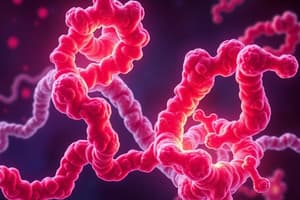Podcast
Questions and Answers
What is the primary function of hemoglobin in the body?
What is the primary function of hemoglobin in the body?
- To store oxygen in muscle cells
- To transport carbon dioxide to tissues
- To facilitate electron transfer during metabolism
- To transport oxygen from lungs to tissues (correct)
Which structural characteristic differentiates hemoglobin from myoglobin?
Which structural characteristic differentiates hemoglobin from myoglobin?
- Myoglobin consists of two polypeptide chains
- Hemoglobin has only one heme group
- Hemoglobin has a quaternary structure (correct)
- Myoglobin has a quaternary structure
In which condition is hemoglobinuria likely to occur?
In which condition is hemoglobinuria likely to occur?
- Strenuous exercise (correct)
- Distal tubular toxicity
- Rhabdomyolysis
- Severe dehydration
What distinguishes myoglobin from hemoglobin in terms of oxygen binding?
What distinguishes myoglobin from hemoglobin in terms of oxygen binding?
What color does urine typically become in hemoglobinuria?
What color does urine typically become in hemoglobinuria?
What test can differentiate between hemoglobinuria and myoglobinuria?
What test can differentiate between hemoglobinuria and myoglobinuria?
What type of oligomeric structure does hemoglobin have?
What type of oligomeric structure does hemoglobin have?
Which of the following is NOT a known cause of hemoglobinuria?
Which of the following is NOT a known cause of hemoglobinuria?
Which statement about myoglobin's structure is correct?
Which statement about myoglobin's structure is correct?
What is the main role of the heme group in hemoglobin?
What is the main role of the heme group in hemoglobin?
Flashcards
What are Heme proteins?
What are Heme proteins?
Proteins that contain a heme prosthetic group and play crucial roles in various biological functions, including oxygen transport, oxygen reduction, and electron transfer.
What is Hemoglobin?
What is Hemoglobin?
The most abundant heme proteins in humans, responsible for carrying oxygen from the lungs to tissues and transporting carbon dioxide from tissues to the lungs.
What is Myoglobin?
What is Myoglobin?
A heme protein found in heart and skeletal muscles, responsible for storing and releasing oxygen within muscle cells.
Describe the structure of Hemoglobin.
Describe the structure of Hemoglobin.
Signup and view all the flashcards
Describe the structure of Myoglobin.
Describe the structure of Myoglobin.
Signup and view all the flashcards
What is Hemoglobinuria?
What is Hemoglobinuria?
Signup and view all the flashcards
What is Myoglobinuria?
What is Myoglobinuria?
Signup and view all the flashcards
What is the Ammonium Sulphate Precipitation Test?
What is the Ammonium Sulphate Precipitation Test?
Signup and view all the flashcards
What is the cause of Hemoglobinuria due to hemolytic anemia?
What is the cause of Hemoglobinuria due to hemolytic anemia?
Signup and view all the flashcards
What is the cause of Myoglobinuria due to Rhabdomyolysis?
What is the cause of Myoglobinuria due to Rhabdomyolysis?
Signup and view all the flashcards
Study Notes
Biochemistry 1 (PHB231) - Hemoglobin Precipitation
- Course: Biochemistry 1 (PHB231)
- Department: Biochemistry Department, Faculty of Pharmacy
- University: October University
- Prepared by: A.L. Heba Elrefaie and T.A. Mariam Sabry
Heme Proteins
- Hemeproteins are proteins containing a heme prosthetic group.
- Functions include oxygen transport, oxygen reduction, and electron transfer.
Hemoglobin and Myoglobin
- Most abundant heme proteins in humans.
- Heme group's primary function is reversible binding of molecular oxygen.
Hemoglobin (Function)
- Present in red blood cells (RBCs).
- Main function: transporting oxygen from lungs to tissues.
- Also transports carbon dioxide from tissues to lungs.
Myoglobin (Function)
- Located in the heart and skeletal muscles.
- Carries and stores oxygen in muscle cells.
Hemoglobin (Structure)
- Quaternary structure.
- Composed of four subunits (2 alpha chains and 2 beta chains).
- Each chain contains a heme group; thus, hemoglobin can bind to four oxygen molecules.
Myoglobin (Structure)
- Tertiary structure.
- Composed of one polypeptide chain (8 alpha helices designated A-H).
- Contains one heme group, binding to only one oxygen molecule.
Hemoglobinuria (Abnormalities)
- Presence of hemoglobin in urine, causing a dark red or brown color.
- Causes:
- Intravascular hemolysis (RBC lysis in the urinary tract).
- Extravascular hemolysis (RBC lysis at a specific gravity less than 1.010).
Hemoglobin and Myoglobin (Abnormalities)
- Excess hemoglobin:
- Hemoglobin exceeds the amount of the hemoglobin-haptoglobin complex.
- Hemolytic anemia.
- Severe burns.
- Blood transfusion reactions.
- Strenuous exercise.
- Infections
Myoglobinuria (Abnormalities)
- Presence of myoglobin in urine, causing a dark red or brown color.
- Causes:
- Rhabdomyolysis.
- This is muscle tissue breakdown and subsequent release of intracellular contents into the bloodstream, including myoglobin.
- Distal tubular toxicity
Ammonium Sulphate Precipitation Test (Chemical Tests)
- Used to distinguish between hemoglobinuria and myoglobinuria.
- Based on the saturation level of ammonium sulfate:
- Hemoglobin precipitates at 80% saturation.
- Myoglobin precipitates at 100% saturation.
Studying That Suits You
Use AI to generate personalized quizzes and flashcards to suit your learning preferences.
Related Documents
Description
This quiz covers important aspects of hemoglobin and myoglobin, focusing on their structures, functions, and roles in oxygen transport and storage. It is designed for students enrolled in the Biochemistry 1 (PHB231) course at October University. Dive into the world of heme proteins and understand their significance in human physiology.



